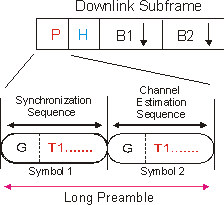
: See 802.16 OFDM Standard Setups/Presets Table.
When demodulating the 802.16 OFDM signal, the VSA uses an equalizer to correct for linear impairments in the signal path, such as multi-path. The 89600 VSA supports two different methods to initialize, or "train," the equalizer: and . Switching between the two methods can help isolate problems contributing to increased RCE (EVM).
The equalizer is trained by looking at the Channel Estimation Sequence in the preamble of the OFDM burst. After this initialization, the equalizer coefficients are held constant while demodulating the rest of the burst.

Advantages of this method of equalization include the following:
The disadvantage of this method is that the measured RCE (EVM) value may be higher for signals whose impairments change during the burst than it would be if the equalizer were trained over the entire burst.
The default value is Preamble Only.
The equalizer is trained by analyzing the entire OFDM burst, including the Channel Estimation Sequence (contained in the preamble) and the Data symbols. This type of training generally gives a more accurate estimate of the true response of the transmission channel.
Advantages of this method of equalization include the following:
The disadvantage of this method is that it is less likely to accurately reflect the performance of a typical OFDM receiver. Because this type of equalizer computation is more complicated and therefore more expensive to implement, it is less likely to be used in practical receivers.
For details about equalization, see application note 1455 "Keysight Equalization Techniques and OFDMA Troubleshooting for Wireless LANs" in the Keysight 89600 VSA Product & Application Notes help.
See Also
Advanced Tab (IEEE 802.16 OFDM Demod Properties)
Copyright © 2000-2023 Keysight Technologies, Inc. |